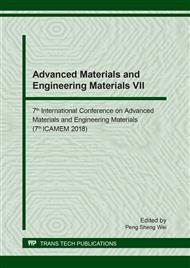p.3
p.8
p.13
p.17
p.22
p.27
p.32
p.37
p.44
High Density Polyethylene/Date Palm Fiber Composites: Effect of Fiber Loadings on the Dynamic Mechanical Thermal Properties
Abstract:
The increasing environmental issues has resulted in the trend of the use of renewable or natural source (green) fillers in the polymer composites fabrication. Among these green fillers is called natural fibers or plant fibers. One particular plant fibers that became the topic of the present work is date palm fiber (DPF). In the present work, DPF at different loadings (i.e. 0, 5, 10, 20, 30 wt%) were incorporated (as fillers) in the high density polyethylene (HDPE) matrix to fabricate HDPE/DPF composites. Further, we have investigated the effect of DPF loadings on the dynamic mechanical thermal properties of the composites. The dynamic mechanical thermal analysis (DMTA) results exhibited that the storage modulus of the composites increased with increasing DPF loadings. Additionally, all the storage modulus values of the composites were higher than the neat HDPE in all temperature ranges. For example, at temperature of 60°C, the storage modulus enhancement of the composites as compared to the neat HDPE were about 26, 76, 134, and 225% for 5, 10, 20, 30 wt% of DPF loadings, respectively. Additionally, the relationship between the DPF loadings (wt%) and temperature (°C) on the storage modulus of the HDPE/DPF composites was modeled using a logarithmic equation. Based on the data plotting between the experimental data and modeled data, the logarithmic equation was found to be fitted with the experimental data satisfactory.
Info:
Periodical:
Pages:
22-26
Citation:
Online since:
August 2018
Price:
Сopyright:
© 2018 Trans Tech Publications Ltd. All Rights Reserved
Share:
Citation:


